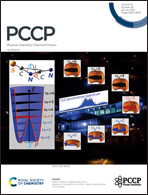Enhancing proton mobility and thermal stability in phosphate glasses with WO3: the mixed glass former effect in proton conducting glasses†
Abstract
This study aimed to investigate the impact of WO3 on the thermal stability of glass, as measured by the glass transition temperature (Tg), as well as the activation energy (Ea) of proton conduction and proton mobility (μH). These parameters were analyzed based on variations in the glass network structure and the nature of the P–O and O–H bonds in 35HO1/2–xWO3–8NbO5/2–5LaO3/2–(52 − x) PO5/2 (x = 2, 4, 6, and 8) glasses. As previously predicted by a linear regression model, replacing PO5/2 with WO3 resulted in an increase in Tg and μH at Tg. The observed enhancement rates were +9.1 °C per mol% of WO3 for Tg and 0.09 per mol% of WO3 for log(μH at Tg [cm2 V−1 s−1]), which aligned with the predicted values of +6.5 °C and 0.08, respectively, validating the linear regression model. The increased Tg was attributed to the formation of heteroatomic P–O–W linkages that tightly cross-linked the phosphate chains. The decrease in Ea and increase in μH at Tg with increasing WO3 content were attributed to the reduction of the energy barrier for inter-phosphate chain proton migration owing to the increasing proton migration paths through P–O–W linkages. This μH enhancement is distinct from previously reported ones due to the reduction of the energy barrier for proton dissociation from OH groups. This phenomenon can be attributed to the mixed glass former effect in proton conducting glass.

- This article is part of the themed collection: 2023 PCCP HOT Articles


 Please wait while we load your content...
Please wait while we load your content...